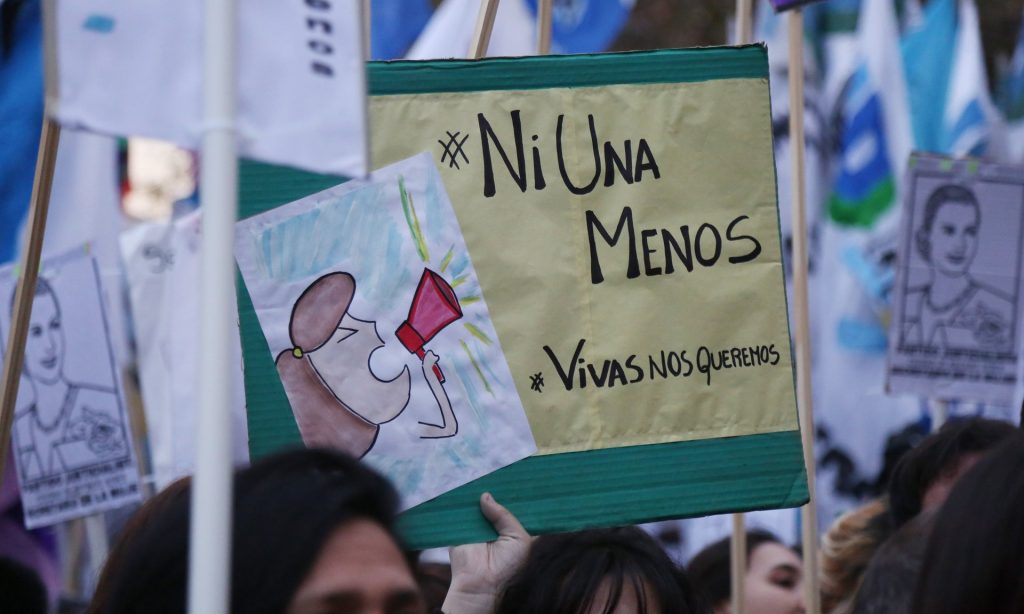
Photograph: Omer Musa Targal/Getty Images
Women’s rights campaigners will take to the streets of Peru on Saturday to protest against sexual violence, in a move described by the country’s women’s minister as “a cry against impunity”.
Organisers estimate that more than 50,000 people could take part in the march in the capital, Lima. Thousands more are expected to participate in about 23 towns and cities across the country.
The march follows protests in Mexico, Bolivia, Colombia, Argentina and Brazil over the past year, under the slogan #NiUnaMenos (Not One Less), which paraphrases the words of murdered Mexican activist and poet Susana Chavez Castillo: “Ni una mujer menos, ni una muerte más” (Not one woman less, not one more death).
Almost daily, headlines tell the story of an epidemic of femicide in Peru.
Last month, the media focused on three cases highlighting the lenient sentences given to perpetrators, lending impetus to Saturday’s march.
“This march is a cry against impunity, it’s a cry for equality and for the decent treatment of women,” said Ana María Romero, Peru’s new minister for women. “It will be a milestone, it will mark a before and after. There’s more citizen awareness about women’s rights.”
The march is just the beginning, according to Romero, 68, who twice served as the minister for women under the government of Alejandro Toledo, whose term as Peruvian president ran from 2001 to 2006. On average, 10 women are murdered every month in Peru, said Romero, while ministry figures indicate a further 20 are victims of attempted femicide.
“If you add to those 10 who lose their lives the 20 victims who are saved by the skin of their teeth, then we are practically talking about one [attack] per day,” she said. “Of those 10 who are killed around six are under the age of 20.”
Romero began her latest stint with a bang by criticising remarks made by Peru’s most senior Catholic cleric, Cardinal Juan Luis Cipriani, the Archbishop of Lima. Speaking on his weekly radio programme, Cipriani made remarks that appeared to tacitly blame women and girls for provoking sexual attacks by dressing provocatively, as if in a “shop window”.
The incoming minister publicly repudiated his remarks, saying his statement “removes all responsibility from the attacker”.
The archbishop apologised for his comments, which the church in Peru claimed had been taken out of context. But Romero said there was no room for misinterpretation.
Women’s rights groups praised her comments, which suggested a change in attitude from her previous terms in office, when she appeared to be “strongly influenced by sectors of the church”, said Susána Chavez, director of Promsex.
The incident has boosted public debate over gender violence and sexist attitudes. Top of the agenda is how to protect vulnerable women when the justice system fails to do so.

Photograph: Courtesy MIMP Peru
CCTV images of a woman called Cindy Arlette Contreras being dragged by the hair through a hotel reception by her naked ex-boyfriend Adriano Pozo were widely circulated on the internet. Pozo received a suspended sentence after a judge ruled that Contreras’ injuries did not suggest any intent on his part to rape or murder her.
In a second widely publicised case, photos of Lady Guillén’s bruised face dating back to 2012 were made public. However, the injuries she suffered at the hands of her ex-boyfriend, Ronny García, were not enough to convince the judge that her life was in danger and García was released after spending four years in prison.
“These cases outraged people and ignited the movement,” march organiser Sasa de la Cruz, said. “But they are just two examples which show women can’t get justice.”
Earlier this week, Peru’s human rights ombudsman, Eduardo Vega, said the state treated female survivors of physical or sexual violence with “absolute neglect”.
According to a 2015 study by Peru’s ombudsman’s office, La Defensoría del Pueblo, in 81% of the studied cases no measures were taken to protect survivors of attempted femicide. As a result, 24% of those women who had sought help were murdered by the assailant they had reported to the authorities, the study concluded.
Romero said the new government, which took office on 28 July, would train police to be more aware of the problem, ensure better provision of psychological support, open more women’s shelters, and establish 245 emergency centres for women across the country.
“Our problem is not a lack of legislation, it is how we apply the law. Those in charge of justice need more sensitivity and a better understanding of the rights of the women,” she added.
Sexual violence is pervasive in Peru, taking many forms. Aside from the number of femicide cases, more than 23% of Peruvian women between 18 and 29 said they had been inappropriately touched on public transport, according to a 2012 study by Lima’s La Católica University.
“It’s fundamental to eradicate the macho and homophobic culture in this country,” Romero said. “Heading towards the bicentenary of our independence we still objectify women or naturalise violent conduct against her.
“That belongs in a primitive era and has no place in the 21st century.”

